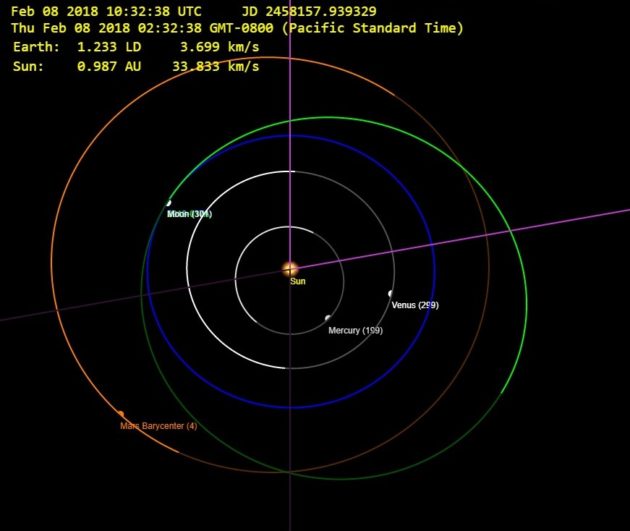
It took a day or two, but astronomers have figured out where the Tesla Roadster launched into deep space aboard SpaceX’s Falcon Heavy rocket is going. And it’s not the planet Mars or the asteroid belt.
Observations of the Roadster, which has a spacesuit-clad mannequin named Starman riding in the driver’s seat, indicate that it’s in an elliptical orbit around the sun that will take it just outside the orbit of Mars and then back to slightly within Earth’s orbital distance.
If you run out the orbit over the foreseeable future, it’s not on a path to run into Earth, or Mars, or any asteroids.

SpaceX’s billionaire CEO, Elon Musk, raised some eyebrows hours after Tuesday’s launch when he reported that the Roadster received more of a push from the Falcon Heavy rocket’s upper stage than expected. He said it was on a course that would take it deep within the asteroid belt between Mars and Jupiter.
Later observations and calculations have shown that it won’t go that far out. Its farthest distance from the sun will be about 158 million miles — a point that it’s slated to reach on its first go-around on Nov. 19.
It’ll come back to just inside Earth’s orbital distance on Sept. 1, 2019, but our planet won’t be anywhere near it at the time. Or any other time.
Jonathan McDowell, an expert orbit-watcher from the Harvard-Smithsonian Center for Astrophysics, provided the lay of the land in a series of tweets:
SpaceX have released orbital data for the escape trajectory. Stay tuned
— Jonathan McDowell (@planet4589) February 8, 2018
Corrected orbital data for the Roadster: 0.99 x 1.71 AU x 1.1 deg
C3 = 12.0, passes orbit of Mars Jul 2018, aphelion November— Jonathan McDowell (@planet4589) February 8, 2018
Bill Gray's ephemeris for the Roadster: https://t.co/BxbZTBTeEx
— Jonathan McDowell (@planet4589) February 8, 2018
The Roadster is now available in JPL Horizons https://t.co/bXvzKWwm8V; select target body -143205
— Jonathan McDowell (@planet4589) February 8, 2018
Using the JPL ephemeris, the closest predicted approach to Mars between now and 2030 is 7 million km on 2020 Oct 8. This is still well outside Mars' gravitational sphere of influence
— Jonathan McDowell (@planet4589) February 8, 2018
In contrast, the Roadster will not return anywhere near Earth by 2030; closest it gets after this month is Mar 2021 at a distant 45 million km
— Jonathan McDowell (@planet4589) February 8, 2018
Summary: Starman will be lonely for a long time to come
— Jonathan McDowell (@planet4589) February 8, 2018
Revised heliocentric orbit using the JPL ephemeris is 0.986 x 1.667 AU x 1.05 deg. (My estimate used a simple patched conic approximation, JPL do the proper job)
— Jonathan McDowell (@planet4589) February 8, 2018
We've found the object about 20 arcmin off from predictions, so it seems that there was some venting. We'll hopefully derive an updated orbit in the next few days
— Jonathan McDowell (@planet4589) February 8, 2018
It doesn't get to the asteroid belt. Elon made that plot while high on Falcon Heavy rocket fumes.
— Jonathan McDowell (@planet4589) February 8, 2018
Congratulations to Jaime Nomen (@ElecnorDeimos, Spain) and Cristovao Jacques (SONEAR, Brazil) who have detected the Falcon/Tesla on its way out of the Earth-Moon system thanks to the orbit data provided by @SpaceX
— Jonathan McDowell (@planet4589) February 8, 2018
CBS News quoted McDowell as saying that the orbit is likely to remain stable for centuries to come, but probably not for the millions of years that Musk was hoping for. That’s because of subtle influences from temperature shifts and Jupiter’s gravitational influence.
“It’s tiny, but over timescales of millions of years it’s enough to shrink the orbit and make the thing fall into the sun,” McDowell told CBS News. “So it’s a race between does that happen before some Jupiter perturbation ejects it from the system.”
If aliens or spacefaring humans come across the Roadster before it’s gone, the car’s Blue Book value might be a bit disappointing. SETI Institute senior astronomer Seth Shostak told NBC News that cosmic rays and the sun’s ultraviolet radiation are likely to degrade the car’s cherry-red paint job (and Starman’s spacesuit) over time. Tiny bits of space grit could ruin the finish as well.
DEIMOS imaging of Tesla – can you spot it moving across the center of the field? https://t.co/WxpOBtoF3S pic.twitter.com/6VKC0NUehu
— Jonathan McDowell (@planet4589) February 8, 2018
Based on the new (better) JPL orbit #3, there will be close approaches in 2047 and 2050. No close approach in 2073. 2047 will be fairly close at 3.1M km (0.02 AU). Those are still quite uncertain, but definitely better than the old one!
— Daniel Bamberger (@renerpho) February 9, 2018
Bookies are already laying odds on where the Roadster will crash: Sportsbet.com.au reports that asteroids are the favored targets, with a $1 bet potentially producing a $2.50 payoff. The sun is No. 2 on the list ($3.50), and a $1 bet will get you $101 if the car crashes into a UFO.
There are two downsides to the proposition, however. First, you have to sign in from a locale where online betting is allowed. And then there’s the little matter of having to wait millions of years to collect your winnings.
As David Bowie sang in the song “Starman”: “Let the children lose it, let the children use it.”



